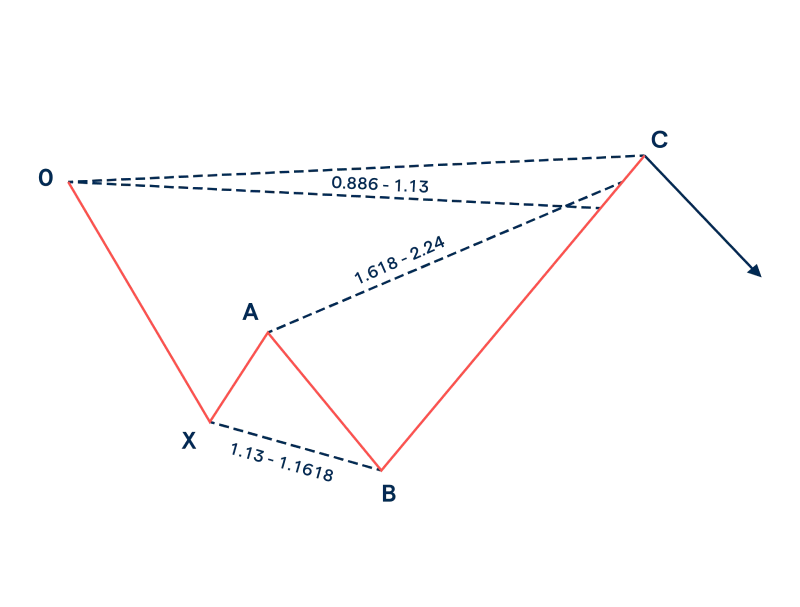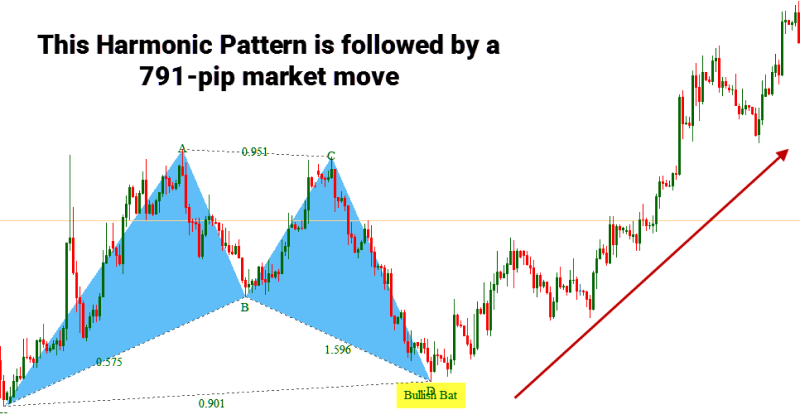Harmonic trading patterns are technical analysis patterns that use specific Fibonacci retracement and extension levels to identify potential reversal points. These patterns provide entry/exit into trading opportunities by identifying geometric price structures. It helps traders with better market timing and improves trade entry/exit accuracy based on fixed levels.
Let’s discuss everything about harmonic patterns and how to trade them.
What are harmonic trading patterns?
Harmonic trading patterns are specific geometric price and time relationships that traders use to identify potential reversals in the financial markets. These patterns are based on the Fibonacci sequence, a mathematical sequence where each number is the sum of the two preceding numbers.
- A bullish harmonic pattern suggests a potential reversal from a downtrend to an uptrend. These patterns indicate potential entry opportunities as sellers may be exhausted and purchasers could gain control, leading to a price increase.
- A bearish harmonic pattern indicates a potential reversal from an uptrend to a downtrend. These patterns suggest potential exit opportunities as they indicate that purchasers may be exhausted and sellers could regain control, potentially leading to a price decline.
Types of harmonic patterns
Gartley pattern
This 5-point pattern resembles a W/M shape. Key retracement levels are based on Fibonacci ratios – 0.618, 1.272, and 2.618. Gartley suggests a potential reversal after a strong trend. Completing the pattern with a confirmation candle at D indicates a potential retracement towards specific price targets based on Fibonacci extensions.
Here’s what each point in the Gartley pattern suggests –
- XA: Strong impulse leg (often the longest leg)
- AB: Retracement of XA, typically between 0.618 and 0.786 of XA
- BC: Retracement of AB, typically between 0.382 and 0.886 of AB. This creates the ‘W’ shape’s bottom
- CD: Extension of XA, often between 1.272 and 1.618 of XA
- Point D: The potential reversal point where price action is expected to bounce
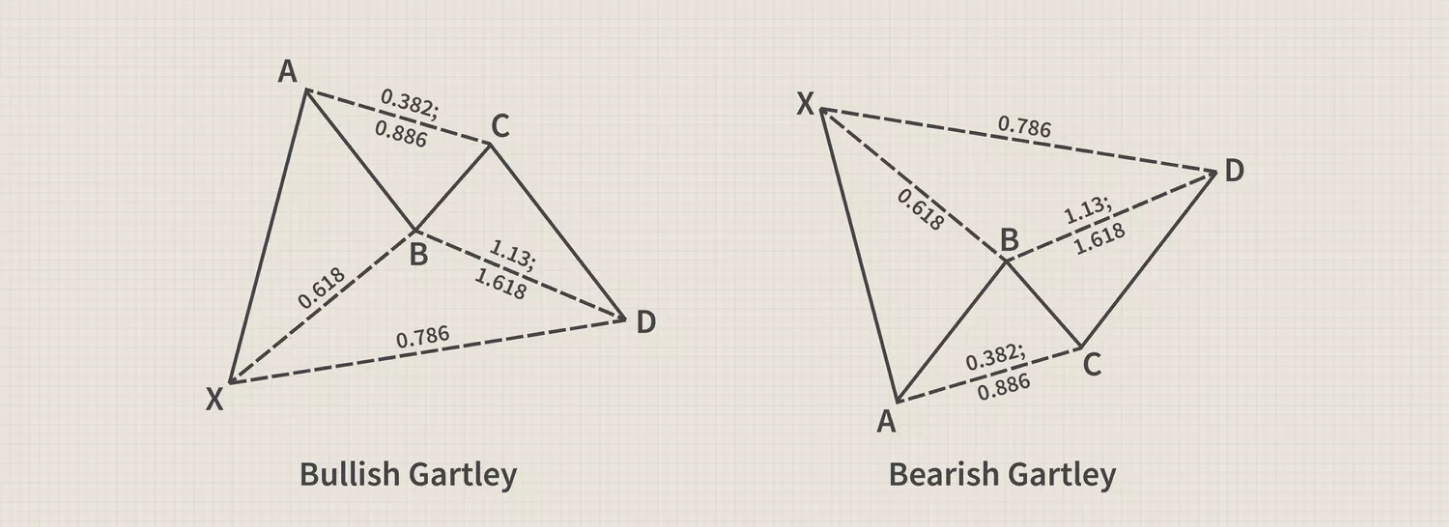
Butterfly pattern
Like the Gartley, this is a 5-point pattern with a “W” or “M” shape. Key retracement levels involve Fibonacci ratios—0.786, 1.27, and 1.618. The Butterfly pattern also suggests a potential trend reversal, with its completion indicating a possible retracement towards specific price targets based on Fibonacci extensions.
Here’s what each point in the Butterfly pattern suggests –
- XA: Strong impulse leg
- AB: Retracement of XA, typically between 0.786 and 0.886.
- BC: Retracement of AB, typically exceeding 1.618 of AB, creating a deeper “W” or “M” than the Gartley
- CD: Similar to XA in length, often reaching between 0.786 and 1.27 of XA.
- Point D: The potential reversal point where price action might reverse
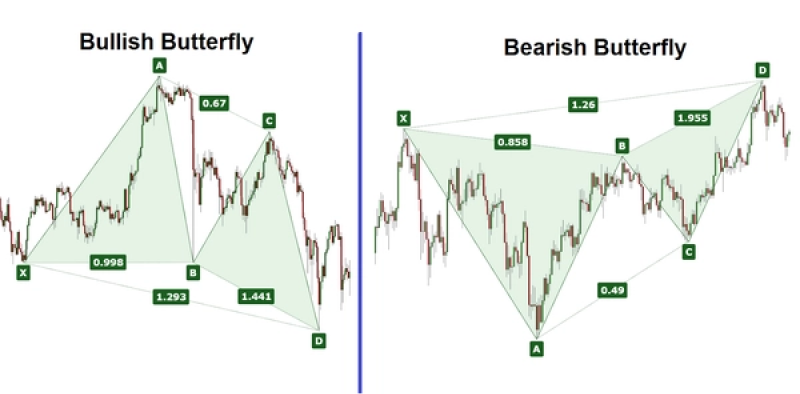
Crab pattern
This 5-point pattern is known for its less rigid Fibonacci requirements (0.382-886 retracements) and a more sideways consolidation than other patterns. Unlike the other patterns suggesting reversals, the Crab pattern suggests a potential continuation of the dominant trend after a temporary retracement. Completion of the pattern with a confirmation at D indicates a possible continuation of the uptrend (for bullish Crab) or downtrend (for bearish Crab).
Here’s what each point in the Crab pattern suggests –
- XA: Strong impulse leg
- AB: Retracement of XA, typically between 0.382 and 0.886 of XA
- BC: Retracement of AB, with a wider range than other patterns (0.382-886 of AB). This creates a sideways consolidation phase
- CD: Similar in length to XA, often reaching between 0.382 and 0.886 of XA
- Point D: The potential continuation point where price action might resume the dominant trend
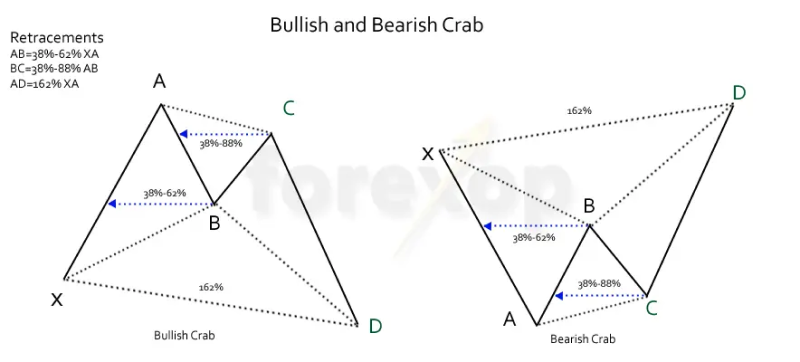
Identifying harmonic patterns
Take a look at the main charts and indicators to identify harmonic trading patterns.
Charts
Candlestick charts show open, high, low, and close prices within a specific timeframe (such as daily, or hourly). A chart filtering minor price movements, focusing on larger trends and potential reversals based on price swings exceeding a set amount. Ensure the price respects key retracement levels and doesn’t break significantly beyond before reaching the confirmation point.
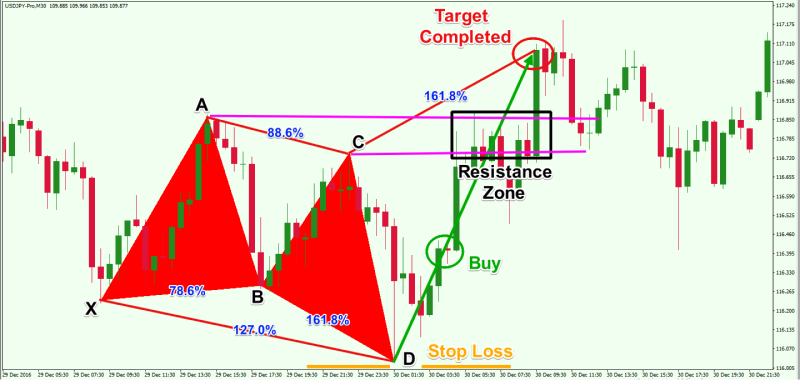
Tick charts
Tick charts focus on price changes (ticks) rather than time, highlighting significant price movements. They create a new bar after a set number of transactions, providing a more dynamic and volume-sensitive view of the market. This can highlight the precise points of pattern formations. Tick charts are particularly useful for identifying intraday harmonic patterns, offering a granular view of price action that can reveal detailed pattern structures.
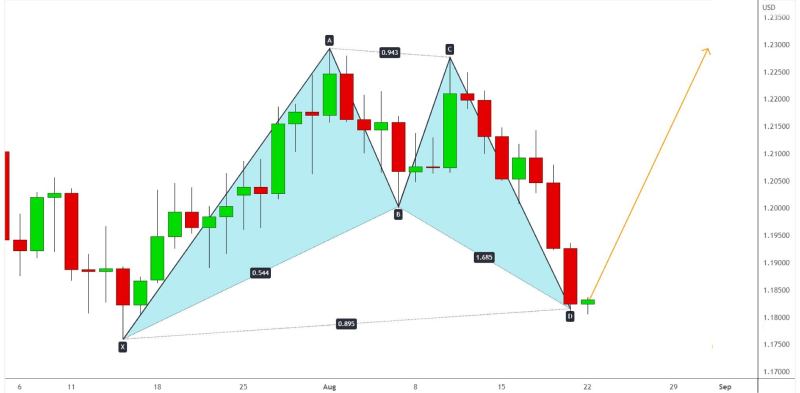
Kagi charts
Kagi charts filter minor price movements, focusing on larger trends and potential reversals based on price swings exceeding a set amount. Kagi charts change direction based on price action rather than fixed time intervals, highlighting significant price movements and trends. The thickness of the lines in Kagi charts provides additional confirmation signals for pattern completion, aiding in accurate pattern identification.
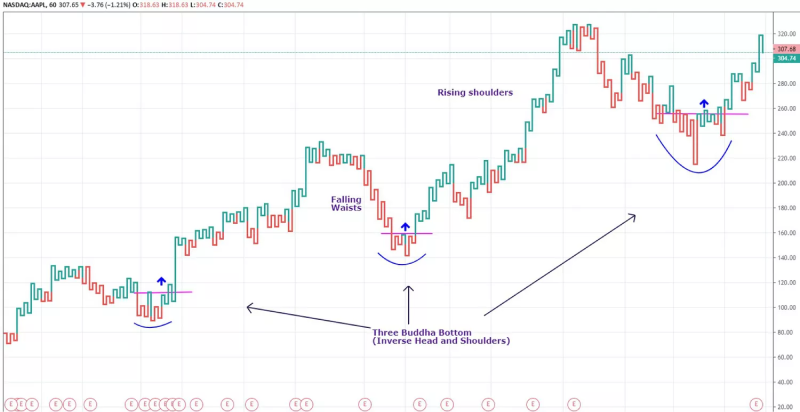
Indicators
Zigzag indicator
The ZigZag indicator connects swing highs and lows, filtering out minor price movements and focusing on significant turning points. By simplifying the price chart and highlighting key turning points, the ZigZag can help identify a harmonic pattern’s potential starting and ending points (XA legs). It can also be used to gauge the overall trend to see if it aligns with the potential reversal or continuation suggested by the harmonic pattern.
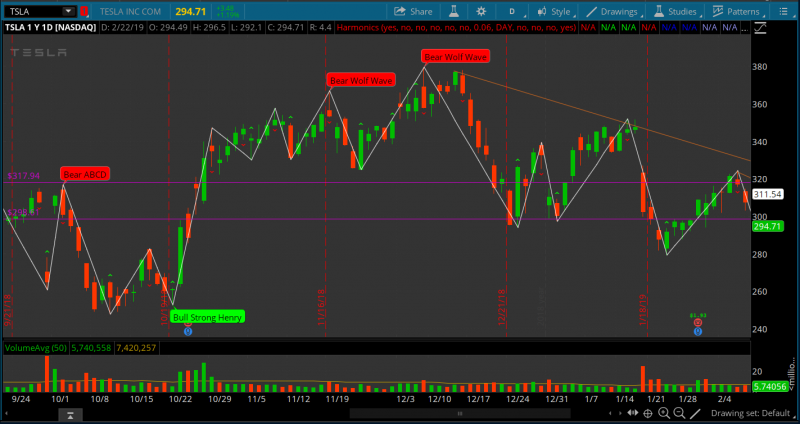
Harmonic Pattern Plus Indicator
The Harmonic Pattern Plus MT4 Indicator is a specific tool designed to automate the identification of harmonic patterns on the MetaTrader 4 (MT4) trading platform. It automatically scans the price chart for various harmonic patterns like Gartley, Butterfly, Bat, Crab, and other user-defined patterns. The Harmonic Pattern Plus indicator also indicates –
- Pattern completion interval: It indicates the zone where the pattern is expected to complete
- Potential Reversal Zone (PRZ): It highlights the area where a price reversal is possible based on the pattern
- Potential Continuation Zone (PCZ): It highlights the area where a trend continuation is possible (for Crab patterns)
- Stop-loss and take-profit levels: It may suggest potential automatic stop-loss and take-profit levels based on the pattern
Step-by-step guide: How to spot harmonic patterns
1. Locate point X
Identify a Significant Swing Point: Look for a prominent swing high (for bearish patterns) or swing low (for bullish patterns) to mark as Point X.
2. Measure XA leg
Draw the Fibonacci retracement from Point X to Point A. Look for retracement levels such as 38.2%, 50%, or 61.8%. This defines the potential reversal zone (PRZ) where the pattern might be complete.
3. Find point A
Point A is at a significant Fibonacci retracement level (such as 61.8%) of the XA leg.
4. Measure AB leg
Draw the Fibonacci extension from Point A to Point B. Look for extension levels such as 0.382, 0.500, 0.618, or higher. Point B should ideally be at one of these extension levels.
5. Find point B
Point B is ideally at a Fibonacci extension level of the AB leg, indicating completion of the AB leg of the pattern.
6. Measure BC leg
Draw the Fibonacci retracement from Point B to Point C. Look for retracement levels like 38.2%, 50%, or 61.8%. Point C should be at one of these retracement levels.
7. Find point C
Point C is at a Fibonacci retracement level of the BC leg, confirming the formation of the pattern.
8. Measure CD leg
Draw the Fibonacci extension from Point C to Point D. Look for extension levels such as 1.272, 1.414, 1.618, or higher. Point D is expected to be at one of these extension levels, marking the completion of the harmonic pattern.
9. Validate the pattern
Ensure that each leg of the pattern adheres to the specific Fibonacci ratios associated with the chosen harmonic pattern. Look for additional confirmation, such as candlestick patterns, divergence, or other technical indicators aligning with the Pattern Completion Zone (PRZ).
Top trading strategies to use with harmonic patterns
Correlation strategy
Traders can identify currencies with a strong correlation to the one they are analyzing. Traders can see if the harmonic pattern forms similarly on both. If the patterns develop in a similar way on correlated currencies, it strengthens the confidence in the original pattern’s validity.
Multiple timeframe analysis
Harmonic patterns can be valid on any timeframe, but understanding the broader trend in higher time frames helps traders interpret the potential outcome. For example, a bullish harmonic pattern on a short time frame might suggest a short-term rally within a downtrend on a higher timeframe. Short-term price fluctuations can create false signals for harmonic patterns. By analyzing the pattern on a larger time frame, traders can smooth out the noise and focus on the underlying trend that the pattern might predict.
Sentiment analysis
Sentiment analysis can provide valuable insights when used alongside harmonic patterns. By incorporating news events, social media sentiment, and investor reports, traders can gauge the overall market bias. If a bullish harmonic pattern coincides with positive news surrounding the underlying asset, it strengthens the case for a potential price increase. Conversely, negative sentiment might suggest a potential reversal even with a bullish harmonic pattern.
Common risks with harmonic trading patterns and how to avoid them
- Market noise or sudden volatility can trigger false breakouts or stop-loss hits within the potential reversal zone (PRZ). Place stop-loss orders outside the PRZ and consider volatility-adjusted position sizing.
- Inconsistencies in identifying harmonic patterns due to human interpretation can lead to false signals. For greater objectivity, utilize pattern recognition software alongside one’s own analysis.
- Over-reliance on historical data for pattern recognition can lead to trading decisions that do not align with current market conditions. To ensure relevance, validate harmonic patterns with multiple timeframes and confirmatory indicators.
Validate market reversal with harmonic patterns
Harmonic patterns, based on Fibonacci ratios and geometric formations like Gartley, help predict potential market reversals.
While harmonic trading patterns offer valuable insights into potential market reversals by leveraging Fibonacci ratios and geometric price structures, traders must remain cautious of several inherent challenges and risks. The accuracy of these patterns heavily relies on precise identification and interpretation, which can be prone to human error.
To mitigate these risks and maximize the reliability and gains of trading harmonic patterns, traders should validate patterns across multiple timeframes and stay informed about market conditions. By doing so, they can enhance the robustness of their trading strategies while navigating the complexities of the financial markets.
Disclaimer: All material published on our website is intended for informational purposes only and should not be considered personal advice or recommendation. As margin FX/CFDs are highly leveraged products, your gains and losses are magnified, and you could lose substantially more than your initial deposit. Investing in margin FX/CFDs does not give you any entitlements or rights to the underlying assets (e.g. the right to receive dividend payments). CFDs carry a high risk of investment loss.





